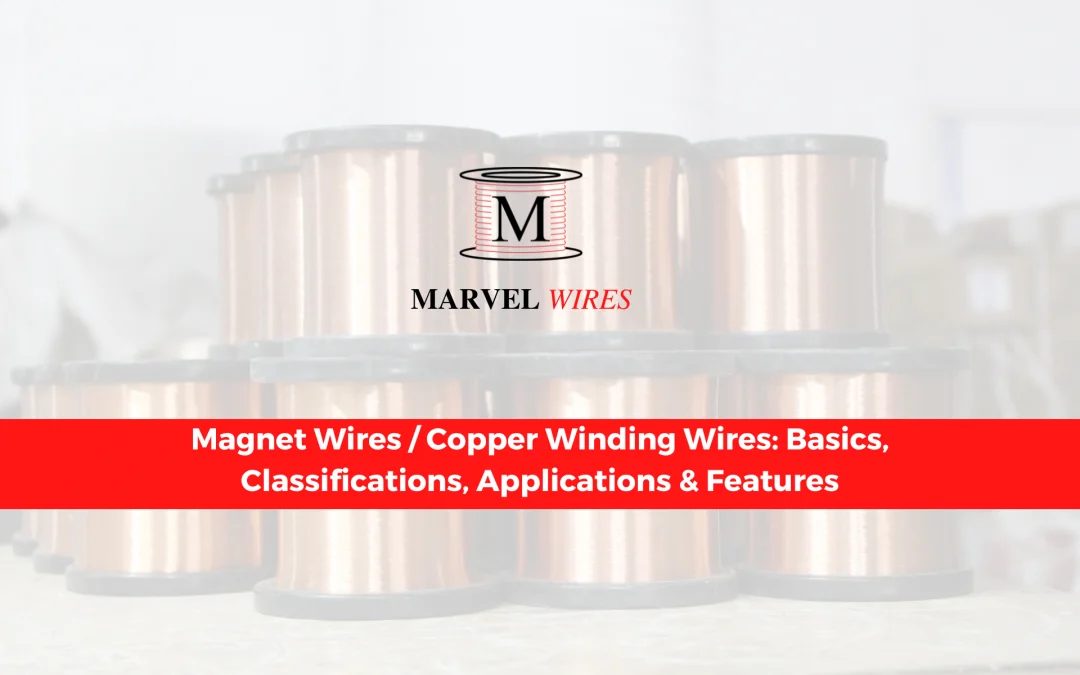Basics, Classifications, Applications & Features
Magnet wire, also known as enamelled or winding wire, is made of copper or aluminium wire coated with a very thin insulation coating. It is used to create tight coils of insulated wire to manufacture transformers, inductors, motors, generators, speakers, hard disc head actuators, electromagnets, electric guitar pickups, and other devices.
Despite being called “enamelled,” magnets or enamelled wire has a layer of vitreous enamel or enamel paint on them. To provide a robust, continuous insulating layer, modern magnet wire often includes one to four layers (in the case of quad-film type wire) of polymer film insulation, frequently of two different compositions. Polyvinyl formal (Formvar), polyurethane, polyamide, polyester, polyester-polyimide, polyamide-polyimide (or amide-imide), and polyimide are used to make magnet wire insulating films (in order of increasing temperature range). Magnet wire with polyimide insulation may function at temperatures up to 240 °C.
To enable closer winding when creating electromagnetic coils, magnet or enamelled wire is typically made of thoroughly annealed, electrolytically purified copper or aluminium. High-temperature applications in reducing atmospheres or in motors or generators cooled by hydrogen gas, high-purity oxygen-free copper grades are employed.
Classifications/Categorization of Enamelled Winding Wires: –
AWG number, SWG, or millimetres, area (square millimetres), temperature class, and insulation class are used to categorize magnet or enamelled wire, much like other types of wire.
Conductor size- It is measured according to the American Wire Gauge (AWG), the Standard Wire Gauge (SWG), or in millimetres or inches
Depth of Insulation- Breakdown voltage is influenced by the covering’s thickness, which comes in three grades: Grade 1, Grade 2, and Grade 3. Greater grades have thicker insulation, which results in higher breakdown voltages.
Enamel type and thermal class- The wire’s temperature class reveals the range of temperatures where it will continue to function for 20,000 hours.
Enamelled Winding Wire & its Manufacturing Process:
The fundamental procedure for producing magnet or enamelled wire begins with the wire extrusion to the necessary dimension, followed by the application of liquid enamel. The enamel is then dried on this wire inside of an oven. The insulation is often applied in several passes, and the wire continuously enters and exits the same oven until the desired insulation is obtained.
Various Features of Enamelled Copper Winding Wires: –
• good electrical qualities, including insulation resistance and dielectric strength
• a robust covering that is resistant to outside pressures, including bending, stretching, and friction
• Heat-resistance
• resistant to chemicals, varnishes, and solvents
• hydrolytic degradation-resistant
• coupled with insulating materials, stable
• Water and moisture-resistant
Applications of Enamelled Copper Wires: –
The enamelled winding wires are used in Electrical Motors, Transformers, Potentiometers, Drum Coils, Household Appliances, Wall Clocks and Watches, Switchgears, Automotive Industries, Pumps and Fans, etc.
About Marvel Wires : –
Incorporated in 1991 and having an 31 years of expertise in the copper winding wires sector, Marvel Wires has been providing enamelled copper winding wires to known OEMs including Polycab, Havells, Orient, Bajaj, and others specifically for industrial use. The company is known for its skilled experience, commitment to manufacturing, quality, and service delivery result in a high-quality product. The products offered are- Polyester, Modified Polyester, Hermetic and Self-Solderable Wires.
It is Northern India’s only copper winding wire company producing ultra-fine copper wires that ranges up to 48 SWG.

